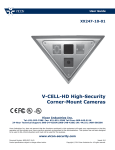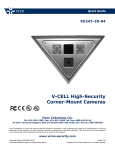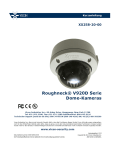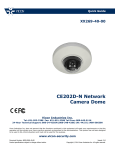Download Vicon XX247-20-04 Product specifications
Transcript
Quick Guide XX247-30-01 V-CELL-HD High-Security Corner-Mount Cameras Vicon Industries Inc. Tel: 631-952-2288 Fax: 631-951-2288 Toll Free: 800-645-9116 24-Hour Technical Support: 800-34-VICON (800-348-4266) UK: 44/(0) 1489-566300 Vicon Industries Inc. does not warrant that the functions contained in this equipment will meet your requirements or that the operation will be entirely error free or perform precisely as described in the documentation. This system has not been designed to be used in life-critical situations and must not be used for this purpose. www.vicon-security.com Document Number: 8009-8247-30-01 Product specifications subject to change without notice. Issued: 114 Copyright © 2014 Vicon Industries Inc. All rights reserved. V-CELL-HD Quick Installation Guide 1. Description The information in this manual provides quick installation and setup procedures for the V-CELL-HD of High-Security Corner-Mounted Cameras. These units should only be installed by a qualified technician using approved materials in conformance with federal, state, and local codes. Read these instructions thoroughly before beginning an installation. Refer to the complete manual for detailed information. Always refer to Vicon’s website to assure you have the most up-to-date manual, http://www.viconsecurity.com. The Roughneck® V-CELL-HD high-security camera is an integrated housing, camera, lens and IR illuminators system specifically designed for use in custodial suites and prison cells. It is available in an IP version that is fully compatible with all ViconNet® systems; its ONVIF certification provides an open-platform for integration into other video management systems. The housing is designed to fit into a corner; once installed, the base plate should be permanently sealed to the wall so that the housing is ligature proof. The housing consists of a two part stainless steel assembly, a fixed base plate and a removable front plate, that allows ease of installation and servicing. The front plate is secured with security screws and has two polycarbonate windows to protect the camera and IR illuminators. The alarm input and alarm output can be used to connect various third party devices, such as door sensors and alarm bells. • Installation Steps Follow these steps to install the network camera on your local network (LAN): 1. 2. 3. 4. Check the package contents against the list that follows. Connect the network camera. Set an IP address. Set the password. • Package Component The system comes with the following components: Camera unit Installation Guide Installation CD Accessory Kit Optional OSD Controller Check your package to make sure that you received the complete system, including all components shown above. Note: Adapter for 12 VDC is not supplied and the optional OSD Controller can be purchased separately. 2 V-CELL-HD Quick Installation Guide 2. Installation For the network camera to operate, it is necessary to connect a network cable for data transmission and power connection from customer-supplied power supply. 2.1 Exploded View Parts and Description ① ② ③ ④ ⑤ Main Power 24VAC/12VDC (↑(+) pole /↓(-) pole) RJ45(PoE) Port Micro-SD Card Slot Alarm & Audio In/Out Port Status LED Upon boot-up, green and red are both on for a short time and then only green will be on. If red is lit, this indicates a failure (no picture); if flashing green and no red, this indicates a good picture is displaying. ⑥ Service Monitor Port 3 V-CELL-HD Quick Installation Guide Quick Installation (without 1. 2. 3. 4. 5. 6. Rear Cover) Use camera mounting frame as template to mark mounting holes on mounting surface. (Fig.1) Drill holes for mounting base and a minimum 3/4 in. hole for routing wines. (Fig.1) Mount camera mounting frame using appropriate hardware for mounting surface. (Fig.2) Route wires through hole in wall and out through base plate. (Fig.2). Terminate wires to camera board. Mount front plate to base plate. (Fig.2) 4 V-CELL-HD Quick Installation Guide Quick Installation (using Rear Cover) 1. Use rear cover as template to mark mounting and cable access holes. 2. Drill mounting and cable access holes in mounting surface. 3. Insert cable clamp into access hole, route cables through clamp and mount cover using appropriate hardware. 4. Use camera mounting frame to mark its mounting holes, drill holes and mount using appropriate hardware. 5. Terminate wires to camera board. Feed the excess wire back through cable clamp and tighten clamp. 6. Mount front plate to camera mounting frame. Note: Installation of the rear cover is required for UL 5 V-CELL-HD Quick Installation Guide 2.2 Connections • Connecting to the RJ-45 Connect a standard RJ-45 cable to the network port of the network camera. Generally a cross-over cable is used for directly connection to PC, while a direct cable is used for connection to a hub. Micro SD memory slot on the board Insert the SD memory card (customer-supplied). • Connecting Alarms Alarm-In: External devices can be used to signal the network camera to react upon events. Mechanical or electrical switches can be wired to the Alarm In and GND connectors. GND (Ground): Connect the ground side of the alarm input and/or alarm output to the GND connector. Alarm Out: The network camera can activate external devices such as buzzers or lights. Connect the device to the Alarm Out and GND connectors. • Connecting the Power Connect the power of 12 VDC or 24 VAC for the network camera. Connect the positive (+) pole to the ‘+’ position and the negative (-) pole to the ‘-’ position for the DC power. Use Certified/Listed Class 2 power source. • Connecting Service Monitor Port The Service Monitor output port is located on the board of the camera and is used for easy OSD setup. ▶ ID & IP assignment To make changes in the OSD menu, the optional OSD controller can be used to set Camera Title and IP Address. 1. 2. 3. 4. Connect the OSD Controller to the Service Monitor port of the network camera. Connect Service Monitor and the Video Output port of the OSD Controller. Press the SET button on the controller to access the Main Menu. Change camera ID and IP address as needed. Additionally, the Name (or title) of the camera can be changed. Use the ↑↓←→ buttons on the controller to change the parameters. 5. Select SAVE or CANCEL to exit the Main Menu. 6 V-CELL-HD Quick Installation Guide The Video Output can also be used for easy zoom and focus control when adjusting the lens. Video Output is restricted to 704x480 (576) resolution. Note: The optional OSD Controller can be purchased separately. 2.3 Network Connection and IP assignment The network camera is designed for use on an Ethernet network and requires an IP address for access. Most networks today have a DHCP server that automatically assigns IP addresses to connected devices. By factory default, your camera is set to obtain the IP address automatically via DHCP server. If your network does not have a DHCP server the network camera will use 192.168.1.100 as the default IP address. If DHCP is enabled and the product cannot be accessed, run the “Smart Manager” utility on the CD to search and allocate an IP address to your product or reset the product to the factory default settings and then perform the installation again. 1. 2. Connect the network camera/device to the network and power up. Start SmartManager utility (Start>All programs>SmartManager>SmartManager); the main window will display. After a short while any network devices connected to the network will be displayed in the list. 3. Select the camera on the list and click right button of the mouse. The pop-up menu displays as below. 4. Select Assign IP. The Assign IP window displays. Enter the required IP address. 7 V-CELL-HD Quick Installation Guide Note: For more information, refer to the Smart Manger User’s Manual. 3. Operation The network camera can be used with Windows® operating system and browsers. The recommended browsers are Internet Explorer®, Safari®, Firefox®, Opera® and Google® Chrome® with Windows. Note: To view streaming video in Microsoft® Internet Explorer, set your browser to allow ActiveX controls. Note: Some screens may appear different (i.e., color scheme) depending on the firmware version, but the functionality is the same or similar. 3.1 Access from a browser 1. Start a browser (Internet Explorer). 2. Enter the IP address or host name of the Network Camera in the Location/Address field of your browser. 3. A starting page displays. Click Live View, Playback or Setup to select corresponding web page. 4. Click Live View for the network camera’s Live View page to appear in the browser. 8 V-CELL-HD Quick Installation Guide 3.2. Access from the internet Once connected, the network camera is accessible on your local network (LAN). To access the network camera from the Internet you must configure your broadband router to allow incoming data traffic to the network camera. To do this, enable the NAT-traversal feature, which will attempt to automatically configure the router to allow access to the network camera. This is enabled from Setup > System > Network > NAT. For more information, see “3.5.7 System>Network>NAT” of User’s Manual. 3.3 Setting the admin password over a secure connection To gain access to the product, the password for the default administrator user must be set. This is done in the “Admin Password” dialog, which is displayed when the network camera is accessed for the setup at the first time. Enter your admin name and password, set by the administrator. Note: The default administrator username is “ADMIN” and password is “1234”. If the password is lost, the network camera must be reset to the factory default settings. See section “3.5 Resetting to the Factory Default Settings” for more details. To prevent network eavesdropping when setting the admin password, this can be done via an encrypted HTTPS connection, which requires an HTTPS certificate (see note below). To set the password via a standard HTTP connection, enter it directly in the first dialog shown above. To set the password via an encrypted HTTPS connection, see “3.5.7 System >Security>HTTPS” of User’s Manual. Note: HTTPS (Hypertext Transfer Protocol over SSL) is a protocol used to encrypt the traffic between web browsers and servers. The HTTPS certificate controls the encrypted exchange of information. 9 V-CELL-HD Quick Installation Guide 3.4 Live View Page The Live View page provides seven screen modes: 1920x1080, 1280x1024, 1280x720, 704x480 (576), 640x480, 352x240 (288), and 320x240. Select the most suitable mode in accordance with your PC specifications and monitoring purposes. 1) General controls Live View Page Search & Playback Page Setup Page Help Page The video drop-down list allows you to select a customized or pre-programmed video stream on the live view page. Stream profiles are configured under Setup > Basic Configuration > Video & Image. For more information, see “3.5.1 Basic Configuration > Video & Image” of User’s Manual The resolution drop-down list allows you to select the most suitable video resolution to be displayed on live view page. The protocol drop-down list allows the selection of the combination of protocols and methods to use, depending on your viewing requirements and on the properties of the network. 2) Control toolbar The live viewer toolbar is available in the web browser page only. It displays the following buttons: The Stop button stops the video stream being played. Pressing the key again toggles the start and stop. The Start button connects to the network camera or starts playing a video stream. The Pause button temporarily stops (pauses) the video stream being played. The Snapshot button takes a takes a picture (snapshot) of the current image. The location where the image is saved can be specified. The digital zoom activates a zoom-in or zoom-out function for video image on the live screen. The Full Screen button causes the video image to fill the entire screen area. No other windows will be visible. Press the 'Esc' button on the computer keyboard to cancel full screen view. The Manual Trigger button activates a pop-up window to manually start or stop the event. 10 V-CELL-HD Quick Installation Guide Use this scale to control the volume of the speakers. Use this scale to control the volume of the microphone. 3) Video Streams The network camera provides several images and video stream formats. Your requirements and the properties of your network will determine the type you use. The Live View page in network camera provides access to H.264, MPEG-4 and Motion JPEG video streams, and to the list of available video streams. Other applications and clients can also access these video streams/images directly, without going via the Live View page. 3.5 Resetting to the factory default settings To reset the network camera to the original factory settings, go to the Setup>System> Maintenance web page (described in “3.5.7 System > Maintenance” of the User’s Manual) or use the Reset button (SW1) on the board of the dome camera, as described below: • Using the Reset Button Follow the instructions below to reset the network camera to the factory default settings using the Reset button. 1. 2. 3. 4. 5. 6. 7. Switch off the network camera by disconnecting the power adapter. Open the camera mount assembly. Press and hold the Control Button (SW1) on the board with your finger while reconnecting the power. Keep the Control button (SW1) pressed for about 2 seconds. Release the Control Button (SW1). The network camera resets to factory defaults and restarts after completing the factory reset. Close the camera mount assembly. CAUTION: When performing a Factory Reset, any previously saved settings will be lost. (Default IP 192.168.1.100) 11 Vicon Industries Inc. Internet Address: www.vicon-security.com HD V-CELL Network Camera 50303765A























